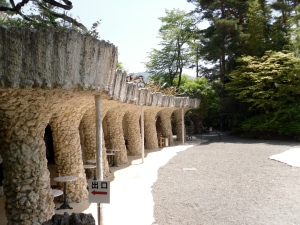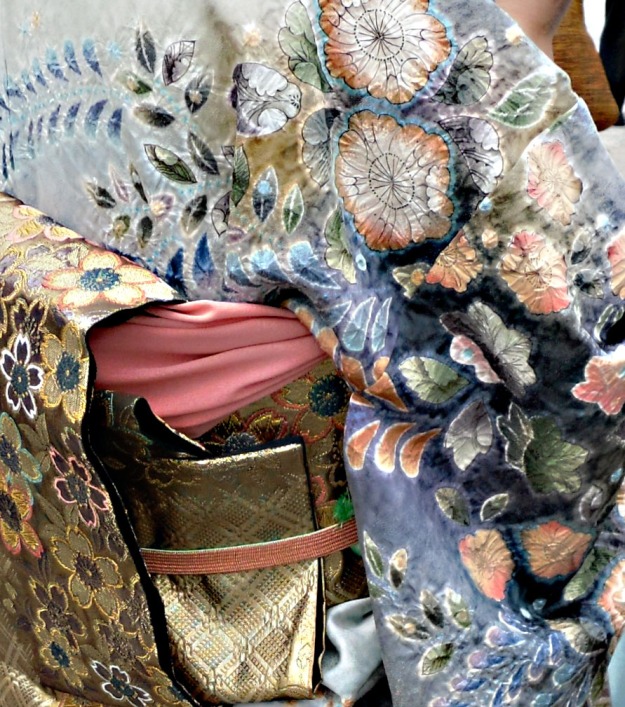Picking up where I left off… on the bus headed to Kawaguchiko and the Ichiku Kubota Museum.
I got off the bus and had to take a local bus that brings you around the lake and deposits passengers at various locations. The museum stop is 45 minutes and towards the end of the route. There were two other Japanese ladies getting off at the same stop and the bus driver requested that they take me with them as the museum was a short walk from the road. It was a good thing too, as it wasn’t immediately obvious how to get to it and I would have had to spend some time finding my way there. I chatted with the ladies along the walk and they offered to share their admission discount coupon with me which I accepted (I actually had my own which I printed from the internet before I left but it would have been rude to mention it). We separated and went on into the museum.

one of my new friends..

rock path in garden

entrance
outside entrance

one of the garden areas

courtyard between the bead display and the kimono display room

garden area behind museum
Much has been written about the architecture of this museum in the various publications covering Ichiku Kubota and his work an the photos here don’t really do it justice. The choices of materials, the natural setting, and the blending of the two are really exquisite. It is so rare for an artist to have an opportunity to create such a setting in which to view their own work. I suppose there must be other examples of it but I am not aware of it at the moment. I’m not speaking of museums devoted to the work of a single artist but such a museum built, designed and curated by the artist him/her self. Of course photos inside were not allowed but I purchased one book that I had never seen before that has fantastic close up images of the fabrics.

So to continue, upon entering the museum the first building is devoted to Ichiku Kubota’s world bead collection. He had collected some fascinating beads -both antique, vintage, and modern in various materials. My favorites were the ceramic beads, having been a ceramicist myself and understanding the unique processes used in the making of many of them. The glass beads were also intriguing. Beautifully displayed as well. This building also houses the museum gift shop and looks out toward the stone arches of a courtyard area.
A walkway and stone staircase lead you up to the real treasure house- the kimono collection.
There is a short video to view beforehand. They even have one in English in a separate area and ushered me into there to view it.
Here is a transcript from my journal written on the bus ride back towards Tokyo-
the sheer beauty of his work leaves you without words to express what it is like to be in the same room with the thirty or so kimono on display here. A short video which was well translated into English was almost worth the price of admission alone. At one point it shows Ichiku Kubota at work with the silk tying and capping …overdubbed is a translation of his words- “it takes so much time…why did I ever think of this?” . Looking over the pieces here I wonder the same thing. The only answer I can come up with is -for the sheer beauty of it. This was a man who was driven to create- conquer the material and perfect a process. Once he had done that he must have felt compelled to continue to create the beauty which he had discovered-tedious though it was. It seems that some people are put on this earth simply to create beauty for the rest of us and Ichiku Kubota certainly did that. The work shown here at his museum and at galleries and shows around the world cannot begin to address the amount of work that must have been created in order to reach these heights of excellence.
Surely there exists some of these experiments- the trials and inventions which led to the development of these wonderful pieces and his unique technique. If you have never done stitched shibori then I wonder if you can fully understand the magnitude of his work.
His museum itself is incredibly gorgeous and strikingly unique. What really struck me is that you can get so up close to the pieces. After removing your shoes you enter the kimono hall to view the works- no glass, no barriers of any kind. You can actually get within centimeters of these pieces. You can really study them. I saw many things that excited and inspired me. Things you cannot see by looking at a book or even from a distance of a meter or more. Let me be clear again. Shibori without texture just doesn’t speak to me in the same way. I don’t think I’ll ever be the same after seeing this exhibit.
Fast forwarding to Kamakura- June Coburn and I had an opportunity to walk up to a favorite shrine near the house where we were staying and saw a Shinto wedding underway. One of the guests was wearing this:

While all the people were taking photos (guests as well as tourists) of the bride and groom in their traditional Japanese wedding costumes, I was following this gal around positioning myself to see the tsujigahana on this fantastic kimono. I don’t think I have ever seen such a kimono ever being worn in public (or private for that matter!) I showed it to my friend (and indigo dyer) and she agreed it most likely was a work of the masters hand-Ichiku Kubota. Yesterday I received two more books on his work from her in the mail- unavailable here and most likely out of print. Not to be believed- I am overwhelmed.
A couple more things to note- from looking at the books I had prior to leaving (never having seen any of his work in person) I did not realize the amazing embroidery that exists on some of his pieces. The subtle variegation in the dyework, the stitching,the overall design, the colors, the silk, the embroidery, the textures, must I go on?
There is one more event of note from this day but I must leave it for now- I think you’ve had enough! I know I have! check out the flickr page for more photos. Going to load them now…

the courtyard is a copy of Gaudi’s colonnade in Parc Guell!!! strange to see it scaled down.and the first photo is very Gaudi too.
neki desu
LikeLike
the one thing that is so important in displaying textiles is being close enough. touching would be the ultimate. so nice to come with you on your tour.
LikeLike
yes, seems i now remember seeing that mentioned somewhere but wasn’t familiar with park guell- googled it and saw the original.
i was just blown away by the ability to really see the details of these pieces.
LikeLike
Oh my goodness, it looks as though you had a wonderful day. That kimono is strikingly beautiful. I love how you love the details and appreciate the craftsmanship, this pours through in your words. Thank you for sharing your trip!
LikeLike
I only recently learnt of Itchiku Kubota and did not know about the museum. Thank you for sharing this experience. The kimono you show is so lovely. What a lucky spot!
Although very different from kimono, the museum reminded me of The Rock Garden at Chandigarh in India. I had never heard of this before visiting Chandigarh and someone recommended visit it. I had no idea what to expect and was blown away by this amazing garden/museum/art space created by a single artist, Nek Chand.
CA
LikeLike
That Kimono is so exquisite it made me gasp.
LikeLike
Oh my, it sounds like you had a wonderful time.
Looking forward to the next instalement in your adventures.
LikeLike
I just returned from two weeks in Japan and visited this museum. I too purchased a book containing photos of all the beautiful kimonos. I even purchased a scarf in the museum gift shop that had several kimono designs on it. This is the one museum that is a must see for anyone visiting this area of Japan. In fact I’m going to try to contact the gift shop to purchase another scarf. Wish me luck. Suzanne
LikeLike